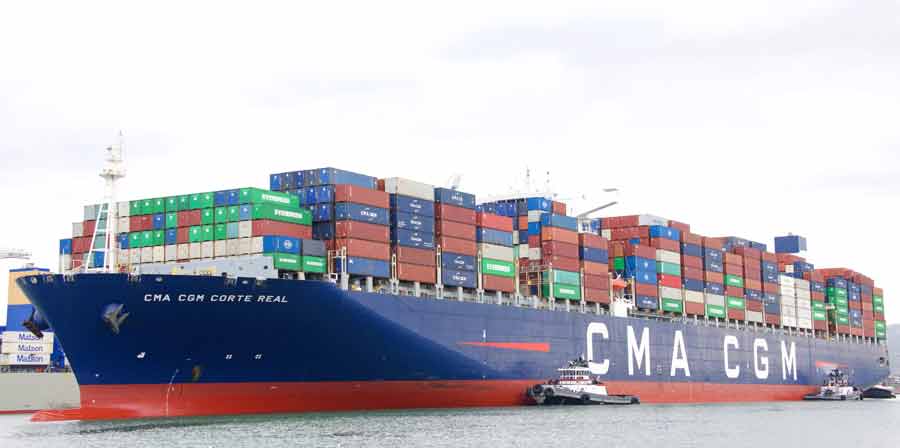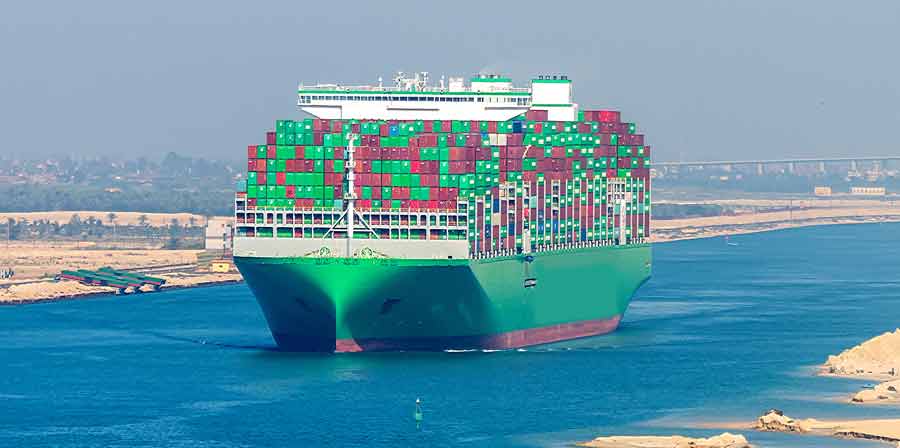In the intricate and ever-evolving landscape of global container shipping, businesses worldwide are facing a sea of challenges. From unexpected disruptions in major canal routes to seasonal variances affecting production and shipping schedules, the industry is navigating through some of its most turbulent waters in recent history. These developments have far-reaching implications, affecting not just shipping lines and logistics providers, but also rippling through the entire supply chain, impacting manufacturers, retailers, and consumers alike.
This article delves into the core of these challenges, offering a detailed analysis of the current state of ocean freight. We will explore the intricacies of canal congestions, geopolitical influences, environmental factors, and the cyclic impact of cultural events like the Chinese New Year on global shipping. Understanding these elements is crucial for companies grappling with the complexities of international trade and logistics.
As we navigate through these topics, we aim to provide a comprehensive overview that not only informs but also equips businesses with the knowledge to make strategic decisions in this dynamic market. Whether you're a seasoned player in the shipping industry or a business indirectly affected by these maritime shifts, this article seeks to shed light on the current scenarios and potential strategies to weather these challenges effectively.
Canal Conundrums – Suez and Panama in the Spotlight
The Suez and Panama Canals are not just waterways; they are the lifelines of global trade, facilitating a significant percentage of the world’s maritime commerce. However, recent times have seen these critical passages under unprecedented strain, leading to a cascade of challenges for companies involved in ocean freight.
The Suez Canal - A Bottleneck of Global Proportions
- Capacity and Delays: The Suez Canal, connecting the Mediterranean to the Red Sea, has experienced significant risks related to recent terrorist attacks by Houthi militia in Yemen. With limited alternate routes, the canal’s capacity constraints become apparent when even a single incident can lead to massive backlogs.
- Ripple Effects: The attacks in the Suez Canal are causing global issues. They are obviously causing direct harm to the attacked vessels and causing an array of ripple effects to the many carriers opting to not use the Canal at this time.
- Cost Implications: These delays have a direct impact on shipping costs. The longer transit times and the uncertainty around passage through the canal have led to increased rates, significantly affecting the bottom line for businesses reliant on these routes.
The Panama Canal - Wrestling with Nature's Whims
- Water Level Concerns: Unlike the Suez Canal, the Panama Canal's recent challenges stem from environmental factors, particularly low water levels. These levels are crucial for the operation of the canal’s lock system, which requires a substantial amount of water.
- Managing Traffic: To cope with these challenges, the Panama Canal Authority has had to implement measures like draft restrictions, limiting the size of ships that can pass through. This has led to scheduling challenges and delays, as larger vessels must seek alternative routes. There are positive signs as they have eased some of the restrictions in the new year.
- Economic Impacts: These restrictions have broad economic implications. The Panama Canal is a key route for goods traveling between the East and West Coasts of the Americas, and delays here ripple through to affect intra-continental trade.
The Domino Effect on Global Shipping
- Port Congestion: The issues in both canals have a domino effect, leading to congestion in major ports around the world. As ships arrive late, ports become overburdened, further delaying unloading and loading operations.
- Strategic Reconsiderations: Faced with these challenges, many companies are reassessing their shipping strategies. Some are holding back their loads, waiting for the situation to stabilize, while others explore alternative routes or modes of transportation.
- The Future Outlook: The big question remains: how long will these challenges persist? Predicting the future in such a dynamic environment is obviously tricky. Companies must stay informed and flexible, adapting their logistics strategies to the evolving situation.
As we look toward the future in the context of the ongoing challenges in the Suez and Panama Canals, it's clear that adaptability and foresight will be crucial for businesses navigating these critical trade routes. The fluctuating scenarios in these canals underline the need for strategic planning and buffer time in global supply chains. Reflecting on this, Robert Skulsky, the Director of International Operations at Jillamy, advises, "Starting the new year, shippers should be building 1-2 weeks into their Global Supply Chain to account for the Panama and Suez Canal delays. Declining water levels in the Panama Canal for the past 20 years, as well as geopolitical uncertainty in the Red Sea, unfortunately, will be the norm for the foreseeable future." This insight from a seasoned industry expert underscores the importance of integrating flexibility into logistics strategies to mitigate the impacts of these ongoing challenges.
Suez Canal Saga – Risks and Responses
The Suez Canal, a crucial shortcut between Europe and Asia, has recently become a focal point for heightened risks and strategic reevaluations in the shipping industry.
Elevated Security Concerns
- Geopolitical Instability: The region around the Suez Canal has seen increasing geopolitical tensions. These tensions have raised concerns over the safety of vessels and cargoes passing through the canal.
- Piracy and Security Threats: Beyond political instability, there are increased risks of piracy and other maritime security threats to the ships, crews and goods with the recent attacks by the Houthi militia. These risks add another layer of complexity for shippers considering this route.
Operational Challenges
- Traffic Congestion and Delays: The canal's narrow structure and heavy traffic make it prone to congestion. Even minor incidents can lead to significant delays, as seen in the recent blockage caused by the Ever Given container ship.
- Navigational Difficulties: The Suez Canal's narrow passages require precise navigation. The pressure on ship captains and pilots is immense, as any error can lead to blockages and delays. When you add the possibility of terrorist attacks on the ships, it becomes unviable and many ships must simply opt for the longer route around Africa.
Insurance Implications
- Increased Premiums: Due to the heightened risks, insurance companies are becoming more cautious. Some have increased premiums for cargo passing through the Suez Canal, while others have announced the suspension of their insurance coverage, citing the increased risk.
- Insurance Availability: The reluctance of insurers to cover cargoes through the canal without substantial premiums is a significant concern for shippers. This has led to additional costs and complexities in securing the necessary insurance for shipments.
Carrier Responses
- Alternate Routes: In response to these challenges, many carriers have canceled lines through the Suez Canal and started rerouting their vessels around the Cape of Good Hope. While this adds significant time to voyages, it avoids the risks associated with the Suez Canal.
- Yang Ming and Wan Hai's Approach: Carriers like Yang Ming and Wan Hai have opted to continue using the Suez Canal route. To mitigate risks and cover additional costs, they have implemented surcharges. This decision reflects a calculated risk, balancing the shorter route's benefits against the increased costs and risks.
- Cost-Benefit Analysis for Shippers: Shippers now face tough decisions. The choice between longer, seemingly safer routes and the shorter, riskier Suez Canal route involves a complex cost-benefit analysis. Factors like time sensitivity of cargo, cost implications, and risk tolerance are all part of this decision-making process.
Looking Ahead
- Monitoring the Situation: The situation in the Suez Canal is dynamic, and shippers must stay informed about the latest developments. Keeping abreast of geopolitical changes, security updates, and carrier policies is crucial.
- Flexibility and Contingency Planning: In these uncertain times, flexibility and robust contingency planning are essential for shippers. Exploring different shipping options, reassessing route choices regularly, and staying prepared for sudden changes are key to navigating this challenging landscape.
Panama Canal Predicament – Awaiting Rainy Relief
The Panama Canal, an engineering marvel and a pivotal shortcut between the Pacific and Atlantic Oceans, is currently grappling with its own unique set of challenges.
Environmental Challenges and Water Management
- Water Level Variability: The canal’s functionality is heavily dependent on the water levels in Gatun Lake, its main water source. Recent years have seen fluctuating water levels, mainly due to varying rainfall patterns attributed to climate change.
- Impact on Canal Operations: Low water levels directly affect the operation of the canal's locks, which require a certain amount of water to function efficiently. This has led to the imposition of draft restrictions, limiting the size and weight of ships that can pass through the canal.
Operational Implications for Shipping
- Delays and Scheduling Issues: Draft restrictions and other water management measures often result in delays and scheduling challenges for shipping lines. Ships that exceed the current draft limits must either offload cargo to meet the restrictions or find alternative routes.
- Increased Costs and Logistical Complexity: These restrictions not only delay transit but also increase costs for shippers. The need to offload cargo or reroute ships adds to logistical complexity and operational expenses.
Strategies Employed by the Canal Authority
- Adaptive Water Management: The Panama Canal Authority has been employing adaptive strategies to manage water levels, including water-saving basins that recycle water used in the locks.
- Infrastructure Improvements: Long-term plans include infrastructure projects aimed at increasing the canal's water storage capacity, ensuring more consistent and reliable operations in the future.
Impact on Global Trade
- Route Alternatives and Strategic Decisions: The delays and restrictions in the Panama Canal force shippers to reassess their routing options. For some, the longer but unrestricted passage around Cape Horn or the Strait of Magellan might become a viable alternative.
- Flexibility and Preparedness: Shippers navigating these waters need to remain flexible and prepared for changes. Staying updated with the latest advisories from the Canal Authority and working closely with shipping lines for timely information is crucial.
Hope for Rainy Season Relief
- Seasonal Expectations: February typically marks the start of the rainy season in the region, which could help replenish the water levels in Gatun Lake. This brings a hopeful outlook for easing some of the current operational constraints and the Canal Authority has already eased some restrictions.
- Monitoring Weather Patterns: Shippers and the Canal Authority alike keep a close watch on weather patterns, hopeful that increased rainfall will mitigate the current challenges and restore smoother operations.

Chinese New Year – The Ripple Effect on Ocean Freight
The Chinese New Year, a significant cultural and economic event, has a profound impact on the global shipping industry. With the 2024 celebration starting on February 10th, let's explore how this festival affects ocean freight and what shippers can expect.
Cultural Significance and Industrial Slowdown
- Holiday Observance: The Chinese New Year, also known as the Spring Festival, is the most important holiday in China. It involves a week-long public holiday, but its effects on manufacturing and shipping start weeks in advance and last well beyond the official holiday period.
- Factory Shutdowns: Many factories in China shut down during this period, leading to a slowdown in production. This results in a reduction of goods available for export, affecting supply chains globally.
Pre-Holiday Rush and Post-Holiday Lull
- Surge in Shipments Pre-Holiday: In anticipation of the shutdown, there's often a surge in export activity as manufacturers rush to ship out goods before the holiday begins. This can lead to congestion at ports and increased demand for shipping containers and space on vessels.
- Post-Holiday Delays: Following the holiday, there's typically a lull in shipping activity. It takes time for factories to ramp up production and for workers to return to their jobs, resulting in delayed production and subsequent shipping.
Impact on Shipping Schedules and Rates
- Scheduling Challenges: The fluctuation in shipping volumes before and after the Chinese New Year creates challenges in scheduling for shipping lines. Carriers often adjust their services in response to the expected drop in demand.
- Blank Sailings: Shipping lines may implement 'blank sailings' (cancellations of scheduled services) during this period, further complicating scheduling and availability for shippers.
- Rate Fluctuations: The pre-holiday rush often leads to increased freight rates due to higher demand, while the post-holiday period may see a dip in rates due to reduced volumes.
Strategies for Shippers
- Advance Planning: Shippers should plan well in advance to navigate this period effectively. Booking shipments early before the rush and anticipating potential delays is key.
- Flexibility in Scheduling: Flexibility with shipping schedules and being prepared for rate fluctuations can help mitigate some of the challenges associated with the Chinese New Year.
- Alternative Arrangements: Exploring alternative shipping routes or modes of transport might be necessary to avoid delays and secure space on vessels.
Looking Ahead
- Monitoring the Market: Keeping a close eye on market trends and staying informed about carrier announcements regarding blank sailings and schedule changes is crucial during this period.
- Collaboration with Freight Partners: Working closely with freight forwarders and logistics partners can provide valuable insights and assistance in managing the disruptions caused by the Chinese New Year.
Navigating Through the Storm – Short-Term Solutions for Shippers
In the current climate of ocean freight challenges, it's crucial for shippers to explore and understand short-term solutions that can help mitigate delays and maintain the flow of goods. Here’s a deeper look at some practical strategies:
Alternative Routes: Circumnavigating Africa
- Route Around Africa: With the Suez Canal posing significant risks, one alternative is the route around the Cape of Good Hope. While historically longer, it avoids the congestion and geopolitical risks associated with the Suez Canal.
- Timeframe Considerations: This detour adds approximately 10-12 days to the journey, depending on the origin and destination ports. Shippers need to weigh the added time against potential delays and uncertainties in other routes.
- Cost Implications: Although longer, this route may offer more predictability in some cases, which can be valuable for planning and managing supply chain expectations.
Transcontinental Shipping Options: East to West Coast USA
- Shipping to the West Coast: For cargo destined for the East Coast of the United States, one strategy is to ship to West Coast ports and then transport goods overland across the country.
- Line Haul to the East Coast: This involves using rail or truck services to move cargo from ports like Los Angeles or Seattle to East Coast destinations.
- Cost and Time Analysis: While this method can be roughly double the cost, it offers an alternative timeline of around 21 days. The key is to balance the higher costs with the benefits of reliability and reduced ocean transit time.
Short-Term Tactical Decisions
- Assessing Immediate Needs: Shippers should assess their immediate shipping needs, considering factors like the urgency of the cargo, budget constraints, and the potential impact of delays on their operations or customers.
- Flexibility and Adaptability: Being flexible and open to adapting strategies is vital. The shipping landscape is rapidly changing, and what works today might not be the best solution tomorrow.
Working with Logistics Experts
- Expert Guidance: Navigating these complex decisions can be challenging. Collaborating with logistics experts and freight forwarders who have a pulse on the latest developments and alternative routes can be invaluable.
- Customized Solutions: Every shipping situation is unique. An experienced logistics partner can help tailor solutions that best fit a company’s specific needs, balancing cost, time, and reliability.
Charting a Course Through Today's Ocean Freight Challenges
The current state of container shipping and ocean freight is a tapestry of interconnected challenges. From the congested and risk-prone Suez and Panama Canals to the seasonal disruptions of the Chinese New Year, each factor contributes to a complex global shipping landscape. Shippers are faced with a myriad of decisions, balancing costs, time, and risk amidst environmental concerns, geopolitical tensions, and infrastructural limitations. The need for flexibility, informed decision-making, and strategic foresight has never been greater.
In these turbulent seas, Jillamy emerges as a beacon of guidance and reliability. As a leading third-party logistics provider, Jillamy is uniquely positioned to help businesses navigate these challenges effectively. Here's how Jillamy can make a difference:
- Expert Navigation Through Canal Challenges: With deep insights into the evolving situations in the Suez and Panama Canals, Jillamy can help shippers strategize the most efficient routes, balancing time and cost considerations.
- Adapting to Seasonal Shifts: Jillamy’s expertise extends to managing the ebbs and flows of shipping trends, particularly around key periods like the Chinese New Year, ensuring that clients are prepared for pre-holiday rushes and post-holiday lulls.
- Alternative Route Planning: Whether it's rerouting around Africa or organizing transcontinental shipments from the West to the East Coast of the US, Jillamy has the resources and network to provide practical alternatives.
- Cost-Effective Solutions: Understanding the financial constraints businesses face, Jillamy offers solutions that balance cost-effectiveness with timely delivery, ensuring that the bottom line remains strong.
- Customized Logistics Services: Recognizing that each business has unique needs, Jillamy provides tailored logistics services, ensuring that each client’s specific requirements are met, from warehousing to transportation.
- Proactive Communication and Updates: In a world where change is the only constant, Jillamy keeps clients informed with the latest market developments, enabling them to make proactive decisions.
The challenges in today’s ocean freight market are as diverse as they are complex. However, with Jillamy’s expertise, network, and commitment to customized solutions, businesses can confidently chart a course through these choppy waters. By partnering with Jillamy, companies gain more than a logistics provider; they gain a partner equipped to face any challenge, ready to turn logistical obstacles into opportunities for growth and success.
Contact Jillamy today at 800-592-7449 to speak with our experts on ocean freight and container shipping or you can reach out on our contact us page here.


